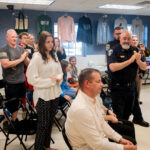Special to the Aroostook Republican in 1967
CARIBOU — In 1857 the first schoolhouse was constructed in the village of Caribou at a cost of $375 on the location of the Sincock School. In 1965 the last schoolhouse to be built by the town of Caribou was erected on the Sweden Road at a cost of $1,280,000. The figures reveal the distance the schools of Caribou have traveled.
 Aroostook Republican file photo
Aroostook Republican file photo
1967: Junior class officers at Caribou High School this year are, from left to right; Jeffrey Dow, president; Beverly Anderson, vice president. Back row: Sue Mae Brown, treasurer; Jo Ellen Anderson, secretary.
In 1858 school was kept three months in the year; the teacher’s board was sold to the lowest bidder, who got it for $1.50 a week. The building was heated by seven cords of wood at 68 cents a cord.
The village grew rapidly after the close of the Civil War and in 1874 a grand two-story building with a belfry was built on the same location and there were 70 or more scholars. This building may be seen in all its sad decay on the location to which it was finally moved, the north side of Herschel Street, west of Nelson Gagnon’s store.
Twelve more years and there were enough young people in town to create a demand for a high school. For five years classes were held in the old Grange building on Sweden Street. It had been a store, and the odor of kerosene and the stickiness of molasses could still be noticed in the corners; but it had an excellent principal, W.S. Knowlton, an educator of the old school, who loved his school and his scholars. The first graduating class had two members, W.E. Sincock and Allen C. Hardison.
 In 1857, the first schoolhouse was constructed in the village of Caribou at a cost of $375 on the location of the Sincock School. The village grew rapidly after the close of the Civil War and in 1874, a grand two-story building with a belfry was built on the same location.
In 1857, the first schoolhouse was constructed in the village of Caribou at a cost of $375 on the location of the Sincock School. The village grew rapidly after the close of the Civil War and in 1874, a grand two-story building with a belfry was built on the same location.
First High School Building
In five years the town had progressed to the stage where it was affluent enough to build a high school building, which was constructed on High Street. At present it is in use as a USO Center.
The story of the school is never complete without some mention of the fine teachers who had such tremendous impact on the lives of the young people they instructed in the early days. One might mention W.P. Hamilton, principal of the high school for seven years; Alice Kelley, whose forthright manner and pungent comments cannot be forgotten; and Annie Bishop, whose warm affection for the pupils brought the response of that little extra effort on their part.
Among many competent superintendents, two women served very efficiently. They were Florence C. Porter and Louise Thomas.
By 1908 the high school building was outmoded and the town authorized the construction of a new building on Glenn Street. Principal Harry M. Wheeler had worked hard for this project and expected to move the high school into its new home for the spring term of 1909. One night in February of that year the Class of 1909 was on a straw ride to the home of a class member in Grimes when looking back toward Caribou they saw a glow in the sky. “Looks like a fire,” chortled one of the class. “Wouldn’t it be fun if it was the school building and we should have a holiday?” When the party reached the farmhouse Mr. Wheeler telephoned back to Caribou. The fire was in the new, almost completed schoolhouse. It was totally destroyed.
Fire Struck Again
That building was replaced with a brick structure but fire struck again on a Sunday, Feb. 23, 1923, when the high school was once more a total loss. As before, heedless youth said “What fun? A Holiday!” But school reopened Monday morning in the vestries of the various churches and arrangements were soon made to rush completion of the already started Catholic parochial school and to lease it to the town until such time as a new high school could be constructed.
The new high school, the present junior high, was dedicated in 1927. The building committee was O.L. Keyes, chairman; Mrs. F.L. Gregory, Grover Hardison, E.E. Powers, N.A. Currier, A.H. Fletcher, H.H. Whitney and George Carter, secretary. Incidentally, Mrs. Gregory was a member of the school board for 21 years. This building had room for an Agricultural Department and for a Home Economics Department.
The Depression Hit
The Depression years hit the schools hard. Teachers voluntarily gave back some of their salaries to the town and accepted a scrip and tax receipts in payment for their work. In spite of a large enrollment of 200 pupils and limited equipment, excellent programs were carried out. The bus system was extended. In the high school, a library was started. Caribou High School was represented by outstanding public speaking, dramatic and debating teams in many statewide contests.
Then came World War II. It brought to the schools major problems of shortaGes in labor and materials but most of all a lack of teachers. Selective Service took some of them but more left for defense jobs. Weekly salaries of $85 to $125 were much more attractive than the $25 which Caribou paid its teachers.
Vocational Shop Built
In spite of these difficulties, a shop was built in 1942 for vocational classes; a course in guidance was started, and adult classes initiated. The curriculum included a toughening course in physical education, two squads in military training, and even a course in aviation. School was held on Saturday so that students would be available to help plant, as well as harvest, during the critical labor shortage. One of the school’s proudest achievements during this period was the sale of $150,000 worth of bonds and the presentation of 15 ambulances to the U.S. Army.
The post war years brought crisis. Due to the scarcity of money during the Depression and the war time shortages, repairs to the buildings had been held to a minimum and no new facility had been added for 20 years; this at a time when the war babies were starting school. Suddenly there was need for everything — new buses, new buildings, more teachers, and at a higher salary scale. The next 20 years were to be a period of rapid expansion in buildings and curriculum to keep up with the needs of Caribou’s children.
Driver education and a comprehensive musical program were added in 1949, and an elementary supervisor was employed. A full fledged testing and guidance program started in 1950.
Teague Park School was built in 1950, but even as its doors were opened it was apparent that this structure was going to be inadequate. A gymnasium and four classrooms were added to the building in 1954, and in 1956 a new junior high school was completed. By 1957, it was possible to close the last of the three rural schools and bus the pupils to the town schools.
Hiltop School, a 20-room elementary school in the southern part of the town, was constructed in 1960, to be followed by an addition to the junior high in 1961. With the additional classrooms, it was possible to start subprimary classes in 1960.
Finally in 1966, a handsome new high school was built on outer Sweden Street. This expensive building program has been carried on largely during the administration of Superintendent Richard Crocker.
The system was completely reorganized with the new high school housing the 10th, 11th and 12th grades, the old high school becoming the junior high for grades 7, 8, and 9, and the former junior high being used for an intermediate school for grades 5 and 6. Grades sub-primary through fourth are being held [at] the neighborhood elementary schools, Teague Park, Hilltop, Sincock, and High Street.
In its seven buildings, Caribou endeavors to furnish its 3,300 students with an education tailored to their needs. There are 155 teachers in the system. Special classes for exceptional students are held at Hilltop and Junior High, remedial reading classes at the Intermediate and Junior High Schools. There is a fine physical education program and a school nurse who serves children from preschool age to 16 years by keeping their health records; screening them for seeing and hearing problems; and setting up immunization clinics. The high school offers courses of study in business, college preparatory, home economics, industrial arts, cultural arts, and vocational agriculture.
But no matter how imposing the school building or how rich the curriculum, the indispensable element in the school is still the teacher. Caribou has, on the whole, been very fortunate in the caliber of its teachers. For length and quality of service, special mention should be made of the late John A. Partridge, principal of the high school from 1922 to 1950; Miss Blanch Farrington, Latin teacher and later Dean of Girls, who taught from 1920 to 1952, and Ernest Pelletier, who retired in 1966 after 35 years as principal of Sincock School, following ten years in other capacities in the Caribou school system. As Caribou becomes a city, it may well look with pride at the school system which it has developed during its 109 years as a town.

Contributed photo
Members of the Caribou High School Class of 1926 were, from left, front row: Naomi Clark, Gertrude Farrington, Beulah Norsworthy, Fern Chapman, Eula Stetson, Edna Hemberg, Phyllis Hallowell, Stella Allen and Marion Hallet. Second row: Ella Howard, Harriet Paul, Helen Denton, Evelyn Hale, Hazel Merrithew, Josephine Lyons, Esther Anderson, Leophile Bouchard, Margaret Hale, Blanche Levasseur and Rena Mills. Third row; Laura Straight, Margaret Haley, Pauline Dudley, Wesley Pierson, Dorothy Pratt, Lendal Page, Beatrice Cunningham, Ralph Wark, Margaret Mooers and Ralph Currier. Fourth row: Dwight Vance, Vesta Alward, Kenneth King, Ada Doyle, Reginald Doyle, Manelva Noyes, Charles Hatch, Helen Briggs, Philip Gould and Ruth Clark. Fifth Row; Margaret Curry, Cleo Ross, Romey Gauvin, Louise Pendell, George Stairs, Cecil Brown, Henry Davis, Hjalmar Johnson, Adrienne Gauvin and Evangeline Gahagan. Margaret Hale was valedictorian of the Class of 1926 and Rena Mills was the salutatorian. Stella Allen delivered the third honor essay.






